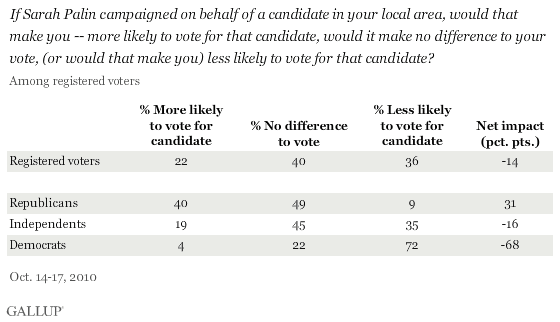WASHINGTON, D.C. -- Sarah Palin's impact on Republican voters is more positive than negative, with 40% of registered Republicans saying they would be more likely to vote for a local candidate for whom she campaigns and 9% less likely to. At the same time, the impact of her campaigning is more negative than positive for independent voters -- and overwhelmingly negative for Democratic voters.

Palin's 31-percentage-point net positive impact on Republican voters is easily less than Bill Clinton's 48-point net positive impact and Barack Obama's 42-point net positive impact on Democratic voters. In this sense she is less of an asset to Republican candidates than the marquee Democratic campaigners are to Democratic candidates. On the other hand, her campaigning on behalf of a candidate is less likely to have a negative impact on independent voters than Obama's, -16 vs. -27. Also, Palin's -68 point net negative impact on Democratic voters is on par with Obama's -69 net negative impact on Republican voters.
The results are from a Gallup poll conducted Oct. 14-17, just before the former Alaska governor began a two-week road trip to campaign on behalf of Tea Party candidates leading up to the midterm congressional elections.
Not surprisingly, Palin's positive influence is greater among conservative Republicans than among moderate and liberal Republicans, including independents who lean Republican. Among conservative Republicans -- 62% of whom are Tea Party supporters -- 44% say Palin's campaigning on behalf of a local candidate would make them more likely to vote for that candidate, and 6% say it would make them less likely to do so. This 38-point net positive impact narrows to 7 points among moderate and liberal Republicans, 25% of whom say Palin's campaigning would make them more likely to vote for a candidate and 18% of whom say it would make them less likely to do so.
Implications
While Palin's influence on Republican voters as a whole is more positive than negative, the concentration of this influence among conservative Republicans underscores the risk factor she brings to the campaign trail. Although her influence on moderate and liberal Republicans is more positive than negative, this is true to a much smaller degree and is more than doubly outweighed by her negative impact on independents. This reality is likely already clear to Republican candidates who have chosen not to appear with Palin on her trips through their area.
Overall, Palin appears to be less of a helpful force on the campaign trail for Republicans than Obama and Clinton are for Democrats. While Palin's influence on independents is less negative than Obama's, the finding that Palin turns off Democrats as much as Obama turns off Republicans is certainly one to consider as Palin mulls the viability of a presidential run in 2012.
Learn more about Gallup's likely voter models for the 2010 midterm congressional elections.
Results for this Gallup poll are based on telephone interviews conducted Oct. 14-17, 2010, with a random sample of 935 registered voters, aged 18 and older, living in the continental U.S., selected using random-digit-dial sampling.
For results based on the total sample of registered voters, one can say with 95% confidence that the maximum margin of sampling error is ±4 percentage points.
Interviews are conducted with respondents on landline telephones (for respondents with a landline telephone) and cellular phones (for respondents who are cell phone-only). Each sample includes a minimum quota of 150 cell phone-only respondents and 850 landline respondents, with additional minimum quotas among landline respondents for gender within region. Landline respondents are chosen at random within each household on the basis of which member had the most recent birthday.
Samples are weighted by gender, age, race, education, region, and phone lines. Demographic weighting targets are based on the March 2009 Current Population Survey figures for the aged 18 and older non-institutionalized population living in continental U.S. telephone households. All reported margins of sampling error include the computed design effects for weighting and sample design.
In addition to sampling error, question wording and practical difficulties in conducting surveys can introduce error or bias into the findings of public opinion polls.
View methodology, full question results, and trend data.
For more details on Gallup's polling methodology, visit www.gallup.com.
